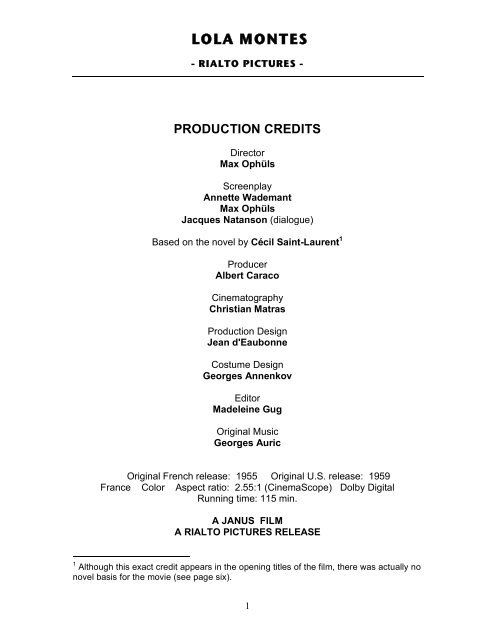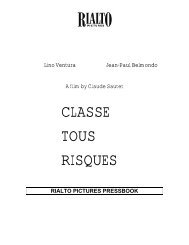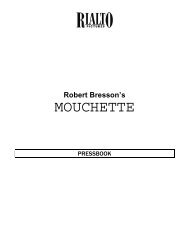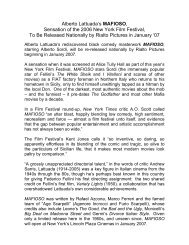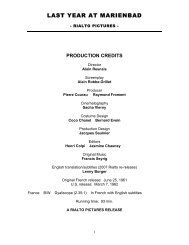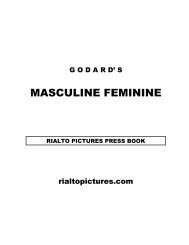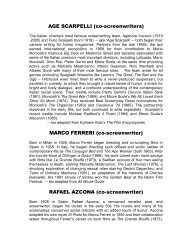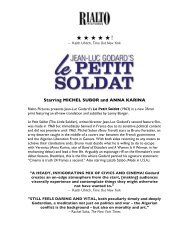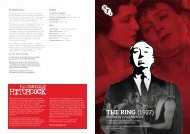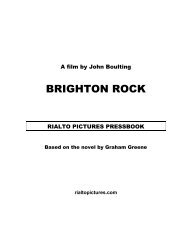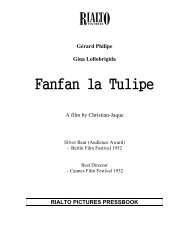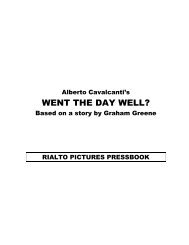LOLA MONTES - Rialto Pictures
LOLA MONTES - Rialto Pictures
LOLA MONTES - Rialto Pictures
Create successful ePaper yourself
Turn your PDF publications into a flip-book with our unique Google optimized e-Paper software.
<strong>LOLA</strong> <strong>MONTES</strong><br />
- RIALTO PICTURES -<br />
PRODUCTION CREDITS<br />
Director<br />
Max Ophüls<br />
Screenplay<br />
Annette Wademant<br />
Max Ophüls<br />
Jacques Natanson (dialogue)<br />
Based on the novel by Cécil Saint-Laurent 1 <br />
Producer<br />
Albert Caraco<br />
Cinematography<br />
Christian Matras<br />
Production Design<br />
Jean d'Eaubonne<br />
Costume Design<br />
Georges Annenkov<br />
Editor<br />
Madeleine Gug<br />
Original Music<br />
Georges Auric<br />
Original French release: 1955 Original U.S. release: 1959<br />
France Color Aspect ratio: 2.55:1 (CinemaScope) Dolby Digital<br />
Running time: 115 min.<br />
A JANUS FILM<br />
A RIALTO PICTURES RELEASE<br />
1 Although this exact credit appears in the opening titles of the film, there was actually no<br />
novel basis for the movie (see page six).<br />
1
<strong>LOLA</strong> <strong>MONTES</strong><br />
- RIALTO PICTURES -<br />
CAST<br />
Lola Montès<br />
Martine Carol<br />
Ringmaster<br />
Peter Ustinov<br />
Ludwig I, King of Bavaria<br />
Anton Walbrook<br />
The Student<br />
Oskar Werner<br />
Lieutenant Thomas James<br />
Ivan Desny<br />
Franz Liszt<br />
Will Quadflieg<br />
Horseman Maurice<br />
Henry Guisol<br />
Mrs. Craigie, Lola's mother<br />
Lise Delamare<br />
Circus Manager<br />
Friedrich Domin<br />
Lieutenant James' Sister<br />
Héléna Manson<br />
Lola Montès has been restored by La Cinémathèque Française in collaboration<br />
with Les Films du Jeudi, Les Films de la Pléiade, Marcel Ophuls, Thomson<br />
Foundation for Film and Television Heritage, The Franco-American Cultural<br />
Fund, DGA – MPAA – SACEM - WGA. With the sponsorship of L’Oréal and<br />
agnès b.; the support of Filmmuseum München, La Cinémathèque Royale de<br />
Belgique, and La Cinémathèque de la Ville de Luxembourg; and the technical<br />
advice of François Ede.<br />
2
<strong>LOLA</strong> <strong>MONTES</strong><br />
- RIALTO PICTURES -<br />
SYNOPSIS<br />
The camera tilts down past ornate chandeliers and a black-faced band to<br />
curtains that part to reveal the Ringmaster of the Mammoth Circus (Peter<br />
Ustinov), who then announces the most sensational act of the century—Lola<br />
Montes! As jugglers fling pins about and clowns enter, Lola (Martine Carol) is<br />
revealed enthroned, and her platform revolves as the Ringmaster invites the<br />
audience to ask questions, at 25 cents per: Where did you dance without a<br />
costume? How many lovers have you had? Do you remember the past? This<br />
cues the first flashback, to her affair with Franz Liszt (Will Quadflieg).<br />
Together they ride in his luxurious coach across the Italian countryside, as her<br />
own coach proceeds behind, presumably as an escape hatch. And in fact they<br />
seem to be intending to end their affair, Lola remarking that life to her is<br />
movement. The next morning at their inn, she calls him back before leaving for a<br />
final kiss, imagining how they would meet again.<br />
Leaving in her carriage segues into her leaving the floor of the circus in a<br />
carriage as the Ringmaster announces twelve tableaux vivantes depicting her<br />
life. Backstage, she receives medicine. As the Ringmaster rhapsodizes about<br />
her early family life, the second flashback begins.<br />
She, her mother, and her mother’s “friend,” Lieutenant James (Ivan Desny),<br />
embark on a ship back to Britain from India in the wake of her father’s death, Lola<br />
being relegated to the dormitory/steerage, while her mother has a cabin to<br />
herself.<br />
In a private box at a Paris theater, Lola’s mother begins negotiations on marrying<br />
her daughter to an elderly baron. Lola flees, followed by Lt. James. He<br />
confesses his interest, and she asks him to save her, to marry her.<br />
As the Ringmaster talks about their happy married life, James returns, seemingly<br />
drunk, from a hunt; Lola accuses him of cheating on her. She tries to walk out,<br />
but he says he’ll never let her go.<br />
Back at the Circus, the Ringmaster speaks of Lola’s dream of being a dancer, of<br />
how it is hard work, as she pirouettes through simple exercises, then skips<br />
through stagings of her triumphs, climaxed by her kidnapping by Cossacks.<br />
While her dalliance with an ambassador is staged behind a screen, the<br />
Ringmaster sings a song about her twelve attributes.<br />
3
<strong>LOLA</strong> <strong>MONTES</strong><br />
- RIALTO PICTURES -<br />
Backstage, a doctor confers with the fully costumed and made-up clown, the<br />
circus’s owner, about his concerns for Lola’s health, noting that she has a weak<br />
heart. The clown is not terribly concerned.<br />
Via flashback, Lola, amid an alfresco dance, humiliates a conductor, who had not<br />
told her he was married, to the applause of the crowd.<br />
In the wake of the scandal with the conductor on the Riviera, the visits to her<br />
hotel mount up, including one from the Ringmaster himself. He offers her a<br />
contract with his circus, telling her that she can’t dance, but that she can trigger a<br />
scandal and that a scandal means money—and in America there are no limits.<br />
She rejects his contract, and when he kisses her, tells him not to be foolish.<br />
In the circus, the trapeze act begins, Lola mounting higher and higher, even as<br />
the net worth of her lovers, as narrated by the Ringmaster, escalates. As she<br />
waits at the top, it’s clear that Lola is exhausted.<br />
The Ringmaster now announces “Lola in Bavaria” and the final flashback begins.<br />
Amid snowy mountains, Lola’s carriage has lost its way, and she asks directions<br />
of a student (Oskar Werner). He gets talked into her carriage—and Lola<br />
immediately sends her maid out to sit with the coachman.<br />
At her hotel in Munich, Lola gets a letter from the Royal Theater accepting her<br />
request for an audition and immediately takes the more expensive room. But she<br />
doesn’t get the job, and as she walks off dejectedly, is befriended by a mounted<br />
officer. It’s clear that, at her behest, he has been trying for six weeks to get her<br />
an audience with King Ludwig I of Bavaria. Lola takes matters into her own<br />
hands, riding through the parade until stopped just short of the King by his<br />
guards. At her ensuing audience, the King (Anton Walbrook) expresses doubts<br />
about her figure, at which she tears open her bodice. The cry of “Needle and<br />
Thread!” echoes through the palace, and after the repairs, he tells her that she<br />
will be accepted by the theater.<br />
From the royal box, the King watches her perform with great interest. In her<br />
dressing room, Lola gets an invitation to the Royal Box and she hurries off, but<br />
the King meets her halfway, on the now deserted stage. Amid the sets, music<br />
stands, and a swaying rope that dangles in the foreground of the shot, the King<br />
dismisses all the hangers-on.<br />
The King announces that he wants a portrait to be painted -- of Lola. At the<br />
Academy, he picks the artist who will take the longest to complete the portrait.<br />
As the artist is working the painting, with Lola posing in winter gear in a sleigh,<br />
the kibitzing King suggests that they lose the cloak—sure to cause another delay.<br />
4
<strong>LOLA</strong> <strong>MONTES</strong><br />
- RIALTO PICTURES -<br />
The Ringmaster, in rhymed couplets, announces that Lola has agreed to pose “in<br />
pink” and that the King had then given her a palace.<br />
Workmen wrestle the large semi-nude portrait into her lavish palace as the King<br />
complains that the National Museum, Library, and Theater have refused to<br />
exhibit it. Lola advises him to fire a few people, ignore the rest, and close the<br />
University. Seeing an ear doctor for his deafness, the King is shown a pamphlet<br />
that apparently decries his relationship with Lola, immediately followed by a brief<br />
montage of printing more pamphlets and impassioned meetings.<br />
Rocks crash through the glass roof of her palace. The King reassures Lola,<br />
saying that if they stop it’s just a riot, but if they don’t, then it’s a revolution. But a<br />
nervous official arrives to tell him that he’s got to go and to take leave of the lady.<br />
Alone in her bedroom Lola nervously plays cards when noises cause her to run<br />
out through the basement of her palace. In a corridor, the Student finds her and,<br />
telling her she’s saved the Royal house, takes her off in a carriage, accompanied<br />
by a guard of his student group. As they escape Munich, he declares his love,<br />
but Lola rejects him, declaring that she did love the King, and that was her last<br />
chance for a haven.<br />
At the circus, the doctor demands that Lola must use a safety net for her jump<br />
and the owner agrees. But the Ringmaster has already announced that no net<br />
will be used; he ultimately leaves it up to her. She is silent and he has the net<br />
dropped, but tells her that he is terrified and couldn’t live without her. She jumps.<br />
In a cage she awaits an endless line of men paying a dollar to kiss her hand as<br />
the camera tracks back, and back …<br />
PRODUCTION NOTES<br />
Lola Montès was originally the idea of Gamma Films, a firm adept at raising<br />
money—albeit on credit--but with little production experience. Its heads were film<br />
salesmen and distributors, plus other assorted businessmen, including the head<br />
of a German brewery. The Swiss partners were brothers whose socialist father<br />
had been kicked out of Italy by Mussolini; a German partner had made business<br />
arrangements for the Nazis in France during the Occupation; and the head of<br />
French Gamma, Albert E. Caraco, was born in Constantinople but flew for the<br />
RAF during the war. Their setup of the Lola Montès production was in many<br />
ways a triumph of packaging, if not of actual producing, worthy of latter-day<br />
Hollywood.<br />
5
<strong>LOLA</strong> <strong>MONTES</strong><br />
- RIALTO PICTURES -<br />
They began with Cécil Saint-Laurent, best-selling author of the “Caroline Chérie”<br />
series, mildly naughty historical novels, often filmed as star vehicles for Martine<br />
Carol, France’s reigning pre-Bardot sex kitten—and he submitted a first draft<br />
early in 1954. (Despite the eventual credit “Based on a novel by Cécil Saint-<br />
Laurent,” there was no original novel; Saint-Laurent published one ten years<br />
later, but it had nothing to do with the film.)<br />
Gamma then searched for a director – prominent on their original wish list was<br />
Michael Powell of Red Shoes fame – but in the summer of 1954 they signed Max<br />
Ophuls, available in the wake of several fizzled projects following his 1953 The<br />
Earrings of Madame De… This was no dream project for Ophuls: “Lola Montes?<br />
That woman doesn’t interest me. It is the people who surround her that excite<br />
me. Her role is roughly the same as that of our pair of earrings in Madame De…”<br />
Ophuls totally rejected Saint-Laurent’s script, immediately writing his own with<br />
regular collaborators Annette Wademant and Jacques Natanson. The framing<br />
device of the circus was apparently present from the first draft.<br />
In September 1954, Gamma then hired-superstar Martine Carol herself for the<br />
title role, while Ophuls was still writing the script. She was not his choice, but the<br />
casting immediately guaranteed full funding for the film, whose budget ballooned<br />
from two million Deutschemarks in 1954 to eight million through filming in 1955<br />
(roughly two million dollars, the same as Ophuls’ 1947 Hollywood flop The Exile),<br />
making Lola the most expensive film made in postwar Europe to date. With the<br />
increased scope of the film, the producers determined to shoot in the then-new<br />
CinemaScope 2 and in three versions, French, German, and English. Although<br />
Ophuls disliked stereophonic sound and was suspicious of Cinemascope, he<br />
received carte blanche in the rest of the casting, a salary of two hundred four<br />
thousand marks—twice the top salary for German directors—and his regular<br />
crew: designer Jean d’Eaubonne, camera operator Alain Douarinou, and director<br />
of photography Christian Matras (who, luckily, was Carol’s own DP of choice). 3<br />
As Ophuls noted to Truffaut, “J’aime les films chers!” – “I love expensive<br />
movies!”<br />
2 CinemaScope, a trademark of 20 th Century-Fox, is an anamorphic widescreen process<br />
invented by Henri Chrétien in the 1920s. Fox introduced it with its new name in 1953’s<br />
The Robe. Lola Montès has been restored to its original CinemaScope ratio of 2.55:1.<br />
(The narrower ratio of 2.35:1 later became the CinemaScope standard; prints made for<br />
Lola’s later reissues were subsequently cropped on the left and right of the screen.)<br />
3 There was one exception: Carol nixed costumer Georges Annenkov, who had trashed<br />
her in print (“Carol’s cute face is as impersonal as the new Soviet National Anthem”),<br />
then okayed him on condition that Marcel Escoffier, costumer on four earlier Carol films,<br />
would dress her, Annenkov everyone else.<br />
6
<strong>LOLA</strong> <strong>MONTES</strong><br />
- RIALTO PICTURES -<br />
Shooting was delayed both because of extensive pre-production work, but also<br />
because Carol’s previous film Nana, directed by her husband Christian-Jaque,<br />
went over schedule and didn’t finish until January 1955. Principal photography<br />
for Lola began on March 1st in Paris and continued in France for thirty-four days,<br />
then resumed in Bavaria, beginning with the “Nadel und Faden!” (Needle and<br />
thread!) scene; the king’s request after Lola’s bodice ripping. This scene alone<br />
took four days: two at the Bavaria Studio in Munich, and two on location at<br />
Schloss WeiBenstein. 4<br />
Five hundred costumed extras were required for the parade scene at the English<br />
Garden in Munich, but it wasn’t sunny enough for the slow color stock of the time,<br />
and everyone had to be brought back on the next sunny day.<br />
Fifty days into shooting, having crashed through its budget and fallen behind<br />
schedule, the production was already having major problems: the negative of the<br />
German version now belonged to a German bank; Martine Carol, whose fee was<br />
twice the director’s, was kept waiting for her next check; Peter Ustinov, who,<br />
because of all the delays, only started work two days before his contract was due<br />
to expire, received a bounced check; and when Caraco arrived in Munich to<br />
negotiate with the French crew regarding overtime and expenses, their<br />
representative, camera operator Douarinou, a communist trade unionist,<br />
threatened a strike. The producers had already been showering Ophuls with<br />
registered letters and injunctions; suitably framed, they decorated the walls of his<br />
dressing room.<br />
Finally, shooting was stopped, and after dramatic conferences with the producers<br />
at Munich’s Four Seasons Hotel, Ophuls, under threat of firing and having to<br />
return his salary, agreed to film the circus scenes, all that remained, in twentyfour<br />
days. 5<br />
On June 28, filming in the circus began with the sweeping first shot of the movie,<br />
tilting down from the chandeliers past a band in blackface to the entrance of<br />
Ustinov’s ringmaster, then tracking backwards ahead of him while curving<br />
4 Situated in Pommersfelden, in Upper Franconia, south of Bamberg, the baroque<br />
schloss was built between 1711 and 1716, features an impressive staircase and is held<br />
in private hands.<br />
5 The Circus Brumbach, complete with staff and animals, was quartered on the grounds<br />
of the Munich studios for several months. It had been previously featured in Elia<br />
Kazan’s Man on a Tightrope (1953). Its Big Top was deemed too small, and the<br />
resulting film set was the largest ever built at the studios, rising higher than the highest<br />
studio buildings, with room for 2000 people and four orchestras.<br />
7
<strong>LOLA</strong> <strong>MONTES</strong><br />
- RIALTO PICTURES -<br />
through lines of jugglers, which would be two minutes of screen time. To conceal<br />
the tracks, 50 meters of packing cloth, the color of the arena floor, were unrolled<br />
by stagehands in the wake of the camera as it moved backwards—the resulting<br />
irregularity in the surface can be glimpsed by eagle-eyed viewers. Despite the<br />
urgency of the impending twenty-four day deadline, the first four hours of the day<br />
were wasted in a dispute over the makeup of the musicians, seen just for a few<br />
seconds in the shot; this first shot was only finally finished at the end of the day.<br />
After five months, a hundred days of shooting, and on the twenty-fourth day in<br />
the circus, filming concluded at 4 a.m. on July 29, after 14 straight hours of<br />
filming all the scenes between the doctor and the clown-costumed circus director.<br />
In Paris, Ophuls edited the three versions -- French, German, and English -- in<br />
three separate cutting rooms, with three editors, leaving several languages in<br />
each version, with subtitles in French and German for the German and French<br />
audiences respectively. 6 "The audience is expecting a cream cake but instead it<br />
gets a punch in the stomach!" Ophuls would write later.<br />
At its French public premiere just before Christmas 1955, audiences got rowdy,<br />
with many demanding their money back, and even warning those waiting in line<br />
in the rain for the next show to avoid it. At a café across the street, Ophuls<br />
lamented to his son Marcel, then his assistant (and later the great<br />
documentarian, whose credits include The Sorrow and the Pity), "I didn’t want to<br />
make an avant-garde movie. I have never tried to make an avant-garde movie. I<br />
wanted to make a commercial movie.” Marcel suggested he had already made<br />
films considered masterpieces, but Ophuls replied “Yes, but you see, Zewen, I<br />
can never go back!”<br />
The critics were equally harsh: “The aesthetics of gurgling and rumbling are<br />
blended with the aesthetics of whipped cream.” “The style is heavily German, as<br />
a result of which the spectacle only feels long and boring.” There were counterattacks<br />
from the film intelligentsia, chief among them from François Truffaut, then<br />
a film critic (see page 14).<br />
After the also unsuccessful Munich premiere, producer Caraco demanded that<br />
each language version be solely in that language, necessitating extensive redubbing;<br />
at that time anywhere from two to three, or five to six minutes were cut<br />
from the images, according to Marcel Ophuls, under the direction of his father,<br />
who in fact thought trimming was advisable in view of the disastrous premiere.<br />
6 Despite some reports, this premiere version never ran 140 minutes.<br />
8
<strong>LOLA</strong> <strong>MONTES</strong><br />
- RIALTO PICTURES -<br />
However, for the English version the producers demanded, against the director’s<br />
wishes, a complete revamping, a version that dumped the flashback structure<br />
and put the whole story in chronological order, beginning with Lola’s youth, was<br />
reduced down to ninety minutes, and re-titled The Sins of Lola Montes. Even<br />
worse, the existing French and German versions, okayed by Ophuls, were recut<br />
to conform with it. French editor Madeleine Gug resigned rather than participate.<br />
This third French version premiered in January 1957, when Ophuls was already<br />
in the Hamburg hospital where he would die in March.<br />
In 1959, Lola finally premiered in New York. It ran 75 minutes, and began with<br />
the last shot of the original version, the track back through the long line of waiting<br />
men.<br />
In the wake of these box office flops, Gamma went bankrupt. Pierre<br />
Braunberger, one of the great producers of the New Wave 7 obtained the rights in<br />
1966 for his Les Films de la Pléiade and proceeded to buy up all the still-extant<br />
elements of the film. In 1967 and 1968, he began to reconstruct the film from its<br />
existing 90-minute version, combing European laboratories in search of the cuts<br />
made from the camera negative, eventually printing up an internegative from<br />
positive separations, with advice from Christian Matras, the director of<br />
photography. With the then state of film restoration, the results were not perfect,<br />
but Braunberger premiered this version, which ran 110 minutes, at his own<br />
theater in 1969, and in the U.S. at the 6 th New York Film Festival that same year<br />
(It had also been shown at the very first NYFF in 1963 8 , in a sidebar of<br />
overlooked films, making Lola the first and only film ever to play the NYFF twice.<br />
Its presentation at the 2008 festival beats even that record: Lola Montès is the<br />
only film selected for the New York Film Festival three times. )<br />
A commercial release across the U.S. followed in April 1969 – the first U.S.<br />
release version that approximated the director’s cut. But, even with this loving<br />
reconstruction, Lola Montès had not recovered its original colors, format, or<br />
soundtrack, or its complete running time.<br />
7 Braunberger’s impressive list of producing credits included Truffaut’s Shoot the Piano<br />
Player, Godard’s My Life to Live, and Rivette’s Le coup du berger. In the 1930s, he<br />
had produced Renoir’s A Day in the Country.<br />
8 It was following the 1963 NYFF screening that Andrew Sarris called Lola Montès “the<br />
greatest film of all time.” (see page 15)<br />
9
<strong>LOLA</strong> <strong>MONTES</strong><br />
- RIALTO PICTURES -<br />
THE RESTORATION<br />
40 years later, film restoration had progressed drastically. Pierre Braunberger<br />
died in 1990, but, in 2006, his daughter Laurence, with aid from the Thomson<br />
Foundation, the Franco-American Cultural Fund, and the Cinémathèque<br />
Francaise, set out on a new quest of discovery. Amazingly, the original sound<br />
mix and “monochromes” 9 were found at Technicolor in Hollywood. Working from<br />
the incomplete original negative, a rough cut, and a very fragile, faded complete<br />
exhibition print, the elements were digitized at Technicolor Creative Services in<br />
Los Angeles, under the supervision of Tom Burton. Scratches, tears, dirt, poor<br />
splicing, and missing frames could then be repaired without additional wear to<br />
the original materials. Over the years, the now-defunct original CinemaScope<br />
format of 2.55:1 had been slimmed down to the now-more standard anamorphic<br />
ratio 2.35:1; this was corrected.<br />
Four magnetic tracks taken from the first Cinemascope copies were resynchronized<br />
to the picture in Dolby Digital. For the restoration of the color, one<br />
print was struck from the original, if shortened, negative, this serving as basic<br />
guideline; Max Ophuls’ own extensive notes specified color schemes for<br />
particular episodes and even contrasts and tones. The resulting digital files were<br />
transferred to negative film and printed normally. “Film remains the only media<br />
that guarantees perennial preservation”—François Ede.<br />
THE REAL <strong>LOLA</strong> <strong>MONTES</strong><br />
Lola Montès – or Montez -- was born Elizabeth (or Eliza) Rosanna Gilbert on<br />
February 17 10 , 1821 in Grange, County Sligo, Ireland. Her father was a British<br />
army ensign in the 25 th Regiment who moved his family to India in 1823, and<br />
almost immediately died of cholera. Her then-19 year old mother remarried<br />
within a year, and “Betsy” was eventually sent back to Britain to school. Noted<br />
for her beauty, intelligence, propensity for mischief, and violent obstinacy, she<br />
attended three different schools before eloping with Lieutenant Thomas James at<br />
16; five years later they separated in Calcutta, and Betsy returned to England,<br />
reportedly after a stopover in Spain, where she steeped herself in the local<br />
dances and adopted Lola Montez as her stage name.<br />
9 Three different b&w negatives, each representing one of the film’s primary colors.<br />
10 She also claimed Feb. 14 as her birthday.<br />
10
<strong>LOLA</strong> <strong>MONTES</strong><br />
- RIALTO PICTURES -<br />
Her sensational dancing debut on June 3, 1843 at Her Majesty’s Theatre<br />
(Wellington and the Queen-Dowager attended) was interrupted when a Lord<br />
Ranelagh bellowed out from the audience that the exotic Lola Montez was really<br />
the prosaic Betsy James. She fled from the resulting scandal to the Continent,<br />
where she became famous and had an affair with the phenomenally popular<br />
composer/pianist Franz Liszt. In 1846 she arrived in Munich and soon became<br />
the mistress of the 60-year-old King Ludwig I, who made her Countess of<br />
Landsfeld in 1847. Her encouragement of his liberalizing tendencies prompted a<br />
popular revolt – a rare reactionary one amid the populist, left wing revolutions<br />
that swept across Europe in1848. Lola showed great personal courage, at one<br />
point emerging onto a balcony above a rioting crowd to toast them in<br />
champagne, but she was ultimately forced to flee, with Ludwig abdicating a<br />
month later.<br />
Returning to London in 1848, she married a cavalry officer but had to flee the<br />
country amid accusations of bigamy (there were questions regarding her divorce<br />
from Lt. James). In 1851, Lola set out alone for the U.S. and made a very<br />
successful fresh start as a dancer and actress. In 1853, she married a San<br />
Francisco newspaperman; that marriage failed and she lived alone in a little<br />
cottage in Grass Valley, California (now a historical landmark) for two years.<br />
Beginning in 1855, she toured Australia, first in a burlesque called “Lola Montez<br />
in Bavaria,” and then creating a sensation with her Spider (or Tarantula) Dance: 11<br />
Miners showered the stage with gold nuggets. Enraged by a bad review in the<br />
Ballarat Times, she horsewhipped the editor in public. Back in America, she<br />
gave lecture tours and published The Arts of Beauty and Lectures (1858), the<br />
latter containing an autobiography. On June 30, 1860, she suffered a stroke and<br />
thereafter walked with a slight limp. She turned to religion, contracted<br />
pneumonia, and died in near-poverty on January 17, 1861. Lola Montez is<br />
buried in Green-Wood Cemetery, Brooklyn. Her unkempt grave is marked “Mrs.<br />
Eliza Gilbert, D. Age 42.”<br />
11 The conceit was that she was shaking an arachnid out of her clothes.<br />
11
<strong>LOLA</strong> <strong>MONTES</strong><br />
- RIALTO PICTURES -<br />
WHAT CRITICS HAVE SAID ABOUT <strong>LOLA</strong> <strong>MONTES</strong>…<br />
"From first moment to last, Lola Montes is a treasure for the<br />
eye, abundant, exciting in its abundance, rich in what Ophuls includes and in the<br />
way he handles it. It is Ophuls' gift for selecting the right element of decor, for<br />
layering every scene with planes of detail ('Details make art,' he said) so that the<br />
characters are always moving through a world that just happens to tell us<br />
something relevant or characteristic about itself at the moment they pass.<br />
Superb: there is not a flaw in the mise en scene, not a dull frame for the<br />
eye." - Stanley Kauffmann, The New Republic<br />
"The last and most spectacularly impressive work of the brilliant director<br />
Max Ophuls. An Ophuls film is always visually delightful to watch, but Lola<br />
Montes exceeded all expectations in the constant succession<br />
of overwhelmingly lovely images. So much 'beauty,' using the term in its most<br />
traditional and unambivalent sense, was crammed into the movie that it almost<br />
became painful to watch. It may well be the most beautiful color<br />
CinemaScope movie ever made. Ophuls uses color with a dazzling,<br />
kaleidoscopic imagination, and manipulates the CinemaScope screen so that it<br />
becomes alternatively larger, more spacious than it has ever seemed before, and<br />
capable of confining the most intimate love scenes. The film unrolls in a dreamily<br />
fluid manner, carried along by Ophuls's smooth, stately tracking and crane shots,<br />
and his breathtaking use of dissolves." - Phillip Lopate<br />
"Ophuls' masterpiece. Every frame of the CinemaScope screen is crammed.<br />
Much motion; deep browns and reds and purples; subdued points of light; the<br />
Ophuls wealth of detail in the Ophuls flux. The film whirls. There is vertigo for us<br />
from camera movement and from midgets dangling off high wires as if they were<br />
on butchers' hooks, and dizziness for Lola, because of the indifference between<br />
the striking morsels of gossip that the public is badgering her for and the past<br />
that is still alive in her. Some directors make film authorship seem very difficult.<br />
Others, like Jean Renoir and Ophuls, make it look like play -- something they do<br />
to enjoy themselves. The fluency of Ophuls' style is balm. The story of his Lola is<br />
transformed by his easy command into something quite at odds with fanmagazine<br />
facts of the narrative. Because of Ophuls' beneficent style, Lola<br />
Montes is majestic and complex. There is a sense that something unique is<br />
being glimpsed in the apparently commonplace and this is nearly as reviving<br />
and moving as the response of Mozart to da Ponte's Cosi Fan Tutte." - Penelope<br />
Gilliatt, The New Yorker<br />
12
<strong>LOLA</strong> <strong>MONTES</strong><br />
- RIALTO PICTURES -<br />
“An extraordinary movie... It is not only Ophuls's last film...but it is also an eyeexpanding<br />
summation of the lush, romantic style... A visibly dazzling ironic<br />
commentary on celebrity.” -- Vincent Canby, The New York Times<br />
“One of the signs of a great director is his ability to sustain a consistent tone<br />
throughout a film. Max Ophuls was such a director, and his Lola Montes has as<br />
much unity of tone as any film I can remember. It is all of a piece from beginning<br />
to end: The mood, the music, the remarkably fluid camera movement, the sets,<br />
the costumes. It is a director's film. The actors are in Ophuls' complete control,<br />
an additional element in his examination of the romantic myth… The device of<br />
the circus is as successful as it is daring. Using it to supply his narrative thread,<br />
Ophuls slides through a series of flashbacks with as much ease, and<br />
psychological completeness, as Welles exhibited in Citizen Kane. The structure<br />
of the film is terribly artificial -- flashbacks suspended from a fantasy circus -- and<br />
the style itself is a highly mannered romanticism. But it works; Ophuls<br />
understands and justifies his method.” – Roger Ebert<br />
“A biography of the celebrated 19th century adventuress, but not a biography in<br />
the conventional sense: the lady's life is chronicled in a highly selective series of<br />
flashbacks, framed by scenes in a New Orleans circus where she allows herself<br />
to be put on show to a vulgar and impressionable public. The space between her<br />
memories and her circus appearance is the distance between romantic dreams<br />
and tawdry reality, or between love and the knowledge that love dies. Ophüls<br />
conjures that space into life - indeed, makes it the very subject of his film - by<br />
means of the most sumptuous stylistic effects imaginable: compositions<br />
unmatched in their fluidity, moving-camerawork that blurs the line between<br />
motion and emotion. If ever a director 'wrote' with his camera, it was Ophüls, and<br />
this still looks like his most sublime work.” – Tony Rayns, Time Out (London)<br />
13
<strong>LOLA</strong> <strong>MONTES</strong><br />
- RIALTO PICTURES -<br />
TRUFFAUT ON <strong>LOLA</strong> <strong>MONTES</strong><br />
Responding to negative criticism against Lola Montès, 23-year old film critic<br />
François Truffaut wrote a lengthy counter-attack, excerpted here 12 :<br />
The cinematrographic year now ending [1955] has been the richest and most<br />
stimulating since 1946. It opened with Fellini's La Strada, and its apotheosis is<br />
Max Ophuls’ Lola Montès.<br />
Like the heroine of its title, the film may provoke a scandal and arouse passions.<br />
If we must fight, we shall; if we must polemicize, so be it.<br />
It is whole cinema that must be defended today, a cinema of auteurs which is<br />
also a visual pleasure, a cinema of ideas where inventiveness informs each<br />
image, a cinema that does not borrow from the prewar period, a cinema that<br />
breaks new paths too long forbidden.<br />
…The way the narrative is constructed, the way it hurries the chronology,<br />
reminds us of Citizen Kane, though now we have the benefits of CinemaScope, a<br />
process here used to the maximum of its potential for the first time…The<br />
structure is new as well as daring; it could well confuse the viewer who lets<br />
himself become distracted or who comes in the middle. Too bad. There are films<br />
that demand undivided attention. Lola Montès is one of them.<br />
The film is constructed rigorously; if it throws some viewers off, it’s because for<br />
fifty years most films have been narrated in an infantile way. From this point of<br />
view, Lola Montès is not only like Citizen Kane, but also The Barefoot Contessa,<br />
Les Mauvaises Recontres, and all those films that turn chronology around for<br />
poetic effect.<br />
The result is less a matter of following a story than contemplating a portrait of a<br />
woman. The image is too full and too rich to see it all at once. The author clearly<br />
intends it that way, going so far as to listen to several conversations at once.<br />
Clearly, Ophuls is interested less in the strong moments of intrigue than in what<br />
occurs in between them. The story that we grasp in scraps—what we perceive of<br />
it helps us to reconstitute the rest as in real life—is brilliantly laconic. The<br />
characters do not sum up situations with elegant formulas; when they suffer, it is<br />
seen, not articulated. Surely this is the most intelligent and precise dialogue<br />
heard in a French film since Jean Vigo’s Zéro de Conduite<br />
12 The complete essay is reprinted in The Films in My Life (1975, Simon & Schuster), a<br />
collection of Truffaut’s film writing.<br />
14
<strong>LOLA</strong> <strong>MONTES</strong><br />
- RIALTO PICTURES -<br />
ANDREW SARRIS ON <strong>LOLA</strong> <strong>MONTES</strong><br />
Perhaps the greatest champion of Lola Montès has been the legendary American<br />
critic Andrew Sarris, who saw it at the first New York Film Festival in 1963. It<br />
was then that he wrote:<br />
"Lola Montès is in my unhumble opinion the greatest film of all time, and I<br />
am willing to stake my critical reputation, such as it is, on this one<br />
proposition above all others.”<br />
When the Braunberger restoration of Lola Montès was released here in April<br />
1969, Sarris again wrote about the film in his weekly Village Voice column:<br />
Back in 1962, I hailed Lola Montès as the greatest film of all time, and I stand by<br />
that judgment…This culminates a crusade I have been waging for the past six<br />
years through two New York Film Festivals. And now, as the big moment<br />
approaches, I find it will take me two or three weeks and several more viewings<br />
to write an adequate critique… Lola is probably the single most important<br />
experience of my critical life, the one film more than any other that has<br />
shaped my aesthetic… Lola is nothing if not pleasurable. I have been told by<br />
authorities in the field that it even fits into the pot [marijuana] scene as it swirls<br />
and swoops through space with its delirious director’s camera. No matter, Lola<br />
Montès is clearly the film of the year, or any year.”<br />
In his landmark book The American Cinema, Sarris placed Ophuls in his rarified<br />
Pantheon of greatest directors, despite the fact that Ophuls made only three films<br />
in Hollywood.<br />
MOLLY HASKELL ON <strong>LOLA</strong> <strong>MONTES</strong><br />
Critic/author Molly Haskell has been married to Andrew Sarris for 38 years.<br />
"I think if I hadn't liked Lola Montès, our relationship might have been<br />
over."<br />
15
<strong>LOLA</strong> <strong>MONTES</strong><br />
- RIALTO PICTURES -<br />
MAX OPHULS<br />
Max Oppenheimer was born in 1902 in Saarbrücken, Germany, near the French<br />
border. His wealthy Jewish family owned a major department store in the town.<br />
Stage-struck early on, he began writing theater reviews in 1920, and thought of<br />
performing in the circus or music halls. But determining to become a stage actor<br />
– thinking of beautiful girls waiting at the stage door, he later said—he began in<br />
regional repertory theaters at 18, taking the stage name Ophuls to avoid<br />
embarrassment to his bourgeois family. Only cast in small parts, he was so<br />
apparently untalented that in 1923 the manager of the Dortmund Theatre<br />
demanded that he double as a director or take a pay cut. He soon dropped<br />
acting and reportedly directed 200 plays at Dortmund, staging operettas at other<br />
theaters. In 1926, he became one of the youngest directors hired by the<br />
prestigious Burgtheater in Vienna, also directing the classics in Frankfurt and<br />
Breslau. In 1930, while staging political plays in Berlin, he was asked to be<br />
dialogue director on Anatole Litvak’s Nie Wieder Liebe, then being filmed in<br />
French and German.<br />
Springboarding from his success there, he directed his first film Rather Cod Liver<br />
Oil (Dann schon lieber Lebertran), a forty minute fantasy, reportedly grabbing the<br />
original novel from the studio library just ahead of Billy Wilder. The full-length The<br />
Company in Love (Die Vierliebte Firma), a comedy about movie people, followed<br />
in 1932. He then filmed Smetana’s The Bartered Bride, with the great clown Karl<br />
Valentin as a circus director. A Czech village was built near Munich and Ophuls<br />
integrated the songs into the action as recitative, turning it into an anarchic<br />
celebration of artistes versus squares—an all too little known minor classic.<br />
After an obscure musical, The Happy Heirs (Die Lachende Erben), Ophuls<br />
achieved his first acknowledged major success, an adaptation of Artur<br />
Schnitzler’s Liebelei, which starred Wolfgang Liebeneiner and Magda Schneider<br />
(mother of Romy). Highlights included a sleigh ride through snowy woods; the<br />
camera circling counterclockwise around dancers who revolve in the opposite<br />
direction; and the finale, with the camera tracking through the now empty<br />
apartment.<br />
This was 1933, and Ophuls and his family left Hitler’s Germany for Paris, where<br />
he immediately directed a French version of Liebelei, re-shooting only the closeups<br />
and dubbing the rest into French.<br />
After a routine mystery story, Ophuls was invited to Italy to make La Signora di<br />
tutti (1934). Beginning with movie star Isa Miranda on the operating table after a<br />
16
<strong>LOLA</strong> <strong>MONTES</strong><br />
- RIALTO PICTURES -<br />
suicide attempt, the (multiple) flashbacks unreel, as Miranda brings catastrophe<br />
to everyone around her. Melodramatic, but critic Claude Beylie called it “the<br />
most musical of Ophuls’ films.”<br />
Back in France, Ophuls made Divine (1935), from a scenario by Colette, a slight<br />
tale of a country girl dancer in Paris, who becomes involved with a (literal) snake<br />
charmer but returns home wiser. François Truffaut later called it “a little<br />
masterpiece, a real little Renoir,” but at the time Ophuls called it his biggest flop.<br />
Ophuls made Komedie om geld in Holland, a satirical comedy about a bank<br />
clerk’s financial shenanigans, complete with a Brechtian street singer framing<br />
device, an almost unseen but quite funny work.<br />
Back in France in 1936, in La tendre ennemie, flashbacks again told the story,<br />
here of a woman, thwarted from marrying the man she loved, who makes both<br />
husband and lover pay, but is prevented by their ghosts from railroading her<br />
daughter into a similarly unwanted marriage. Later that same year, Ophuls was<br />
offered a contract in the Soviet Union, but after a two-month visit, at the height of<br />
Stalin’s purges, returned to France.<br />
Yoshiwara, a triangle story among a Russian naval officer, a geisha, and Sessue<br />
Hayakawa’s rickshaw driver; and an adaptation of Goethe’s Werther; were both<br />
unsuccessful. But despite its slight story—stripper sacrifices herself for love—<br />
Sans Lendemain, with Edwige Feuillère, was well received. Ophuls’ last prewar<br />
film in France was De Mayerling à Sarajevo, with John Loder and Feuillère as<br />
Archduke Franz Ferdinand and the Czech countess he married despite imperial<br />
opposition. Filmed less than thirty years after the actual events, it achieves a<br />
documentary quality in the Sarajevo assassinations finale, with the hunting scene<br />
between Loder and Jean Worms’s emperor a further highlight.<br />
As France fell in 1940, Ophuls and his family fled to Switzerland, where he<br />
directed several plays but could not get film work; and in 1941 they moved to<br />
Hollywood.<br />
For four years he couldn’t get work, living on loans from working European<br />
colleagues, then, aided by Preston Sturges, was assigned Vendetta—but<br />
unfortunately, its producer was Howard Hughes and it became one of<br />
Hollywood’s most legendarily misbegotten projects, Ophuls becoming one of<br />
numerous directors fired from it. Presumably, he at least got paid.<br />
In 1947, aided by friend Robert Siodmak, he was hired by Douglas Fairbanks, Jr.<br />
for his The Exile, with Fairbanks as Charles II, exiled from England to the<br />
Netherlands in the 17 th century: unsung, but an enjoyable and ultimately touching<br />
work, with Ophuls wresting an actual performance from guest star Maria Montez.<br />
17
<strong>LOLA</strong> <strong>MONTES</strong><br />
- RIALTO PICTURES -<br />
Letter from an Unknown Woman (1948), an adaptation of a Stefan Zweig novella,<br />
was dumped by the studio, but is now regarded as a classic. Joan Fontaine, in a<br />
tour de force performance ranging from tremulous youth to disappointed<br />
invalidism, loves and is left by pianist Louis Jourdan, then romantically meets him<br />
again, but when he receives her last letter years later finds he cannot remember<br />
her.<br />
In Caught (1949), Ophuls got his revenge on Howard Hughes in Robert Ryan’s<br />
searing portrait of a loathsome zillionaire whose wife, Barbara Bel Geddes, must<br />
be rescued by doctor James Mason. Mason returned in The Reckless Moment<br />
(1949) as the surprisingly golden-hearted blackmailer of Joan Bennett. At this<br />
time, Mason wrote a poem about Ophuls’ proclivity for moving shots, beginning,<br />
“A shot that does not call for tracks/ is agony for poor old Max.” 13<br />
An adaptation of Balzac’s The Duchess of Langeais, to have starred Greta Garbo<br />
in her comeback, was aborted when the star eventually balked. Ophuls now<br />
began his most successful and best remembered run of films. Adapting a play<br />
by his much-admired Schnitzler, La Ronde (1950) featured eleven stars—<br />
including Simone Signoret, Danielle Darrieux, Gérard Philipe, Anton Walbrook, et<br />
al. -- in a sexual roundelay in turn-of-the-century Vienna. The result was a<br />
resounding international hit, and Ophuls would film with the same technical crew<br />
for the rest of his life.<br />
Le Plaisir (1952) adapted three de Maupassant stories, with a starry cast<br />
including Jean Gabin, Danielle Darrieux, and Simone Simon and Ophuls’ camera<br />
circling but never entering the elaborately-built Maison Tellier.<br />
The Earrings of Madame de… (1953) move from Charles Boyer to extravagant<br />
wife Danielle Darrieux back to a jeweler for cash, who then sells them back to<br />
Boyer who gives them as a farewell to his mistress … ending up with Darrieux’s<br />
diplomat lover Vittorio de Sica, who gives them to Darrieux—with tragic<br />
consequences for all concerned. “The performances by Boyer, Darrieux, and de<br />
Sica are quite likely the finest each has given.” — Pauline Kael.<br />
Lola Montes was his first color film and his most lavish production ever. After its<br />
disastrous reception, he was in Hamburg to direct an opera when the heart<br />
disease from which he had long suffered flared up. He entered a clinic, where he<br />
died in March 1957.<br />
13 The rest of Mason’s poem goes, “…Who, separated from his dolly/Is wrapped in<br />
deepest melancholy./Once, when they took away his crane,/I thought he'd never smile<br />
again.”<br />
18
<strong>LOLA</strong> <strong>MONTES</strong><br />
- RIALTO PICTURES -<br />
No major director has wandered further than Ophuls, filming in five languages,<br />
moving from great successes to the ashcan and back again, with an oeuvre that,<br />
taken overall, remains the most unseen on the usual revival and institutional<br />
circuits. His romanticism, his delving into the intricacies of seemingly trivial love<br />
affairs, his sweeping camera movements, the lack of “serious” themes, his<br />
primary interest in the visual and the non-verbal have divided critics, but his<br />
advocates have been much more passionate than his detractors. As Roy Armes<br />
has noted, “For those whose concern is purely visual and whose ideal is an<br />
abstract symphony of images, Ophuls has the status of one of the very great<br />
directors.”<br />
His son Marcel (born 1927) is the great documentarist, whose films include Hotel<br />
Terminus and The Sorrow and the Pity.<br />
MARTINE CAROL (Lola)<br />
Martine Carol was born Maryse Louise Mourer on May 16, 1920 in Saint-Mandé,<br />
France. After studying acting with renowned teacher René Simon, she made her<br />
stage debut in 1940 and her film debut the following year, first making an impact<br />
in La ferme aux loups/Wolf Farm in 1943. Throughout she remained mostly a<br />
supporting actress, renowned more for being a pinup favorite and for being<br />
kidnapped, briefly, by France’s then public enemy number one -- Pierre Loutrel,<br />
aka “Pierrot le fou” 14 ("Crazy Pete"), who apologized with a rose the next day.<br />
In the wake of a torrid, doomed affair with married actor Georges Marchal, she<br />
drunkenly hurled herself into the Seine, then was saved by the cabbie who had<br />
driven there. Ironically, her suicide attempt became a great career move, with<br />
her popularity/notoriety skyrocketing in the wake of scandal; and in 1950 she<br />
began the series of sexy roles, featuring eye-opening-for-the-50s semi-nudity,<br />
that would make her France’s highest paid actress and its top sex siren pre-<br />
Bardot: Caroline Cherie, Lucretia Borgia, Madame du Barry, Nana -- most of<br />
them directed by her eventual second husband, Christian-Jaque. But aside from<br />
such vehicles, she also worked with André Cayatte (The Lovers of Verona),<br />
Réné Clair (Les Belles de la Nuit), Sacha Guitry (Si Versailles m'était conté),<br />
Preston Sturges (Les carnets de Major Thompson), 15 Robert Aldrich (Ten<br />
Seconds to Hell), Abel Gance (Austerlitz), and Roberto Rosselini (Vanina Vanini),<br />
and had one of the many star cameos in Around the World in 80 Days. When<br />
Brigitte Bardot ascended to the throne as France’s preeminent sex kitten in the<br />
mid-50s, Carol moved to more mature roles and became reclusive. Her fourth<br />
14 Godard’s 1965 film of that title has little or nothing to do with the real Pierrot.<br />
15 Made in 1955, The Notebooks of Major Thompson, in which Carol co-starred with<br />
British variety star Jack Buchanan, was Sturges’ final film as director and screenwriter.<br />
19
<strong>LOLA</strong> <strong>MONTES</strong><br />
- RIALTO PICTURES -<br />
husband discovered her body in the bathroom of their hotel room in Monaco on<br />
February 6, 1967; she had died of a heart attack, age 46 – only four years older<br />
than Lola at the time of her death.<br />
PETER USTINOV (Ringmaster)<br />
Peter von Ustinov was born April 16, 1921 in London, the son of a former flier for<br />
the German air corps in World War I (who would work for Britain’s MI5 during<br />
WWII). His mother Nadia Benois was an artist who worked for the Mariinsky<br />
Theater in St. Petersburg; her brother Alexandre was the designer for Diaghilev’s<br />
Ballet Russe. Overall he was of Russian, German, French, Italian and Ethiopian<br />
descent and was fluent in French, German, English, Italian, Russian and Spanish<br />
and could pass in Turkish and Greek. When asked in what language he dreamt,<br />
his instant reply was “in the abstract.”<br />
He débuted on stage in 1938 and on film in 1940, and, after playing a Dutch<br />
priest in Michael Powell’s One of Our Aircraft is Missing, joined the army as a<br />
private. At one point Colonel David Niven’s batman, he mostly served in the<br />
Army Cinema Unit, co-writing the screenplay for Carol Reed’s The Way Ahead.<br />
Immediately after the war, he wrote and directed three films (School for Secrets,<br />
Vice Versa, Private Angelo) with mixed results, but in the early 50s his play The<br />
Love of Four Colonels was an award-winning smash in New York and London<br />
and, in Hollywood, he stole Quo Vadis? outright as Nero, garnering his first<br />
Oscar nomination. In 1956 his play Romanoff and Juliet was another<br />
transatlantic hit (he would direct and star in a film version in 1961) and he began<br />
appearing on U.S. talk and variety shows—he was a legendary raconteur and<br />
recorded comedy albums as well. He won his first Supporting Actor Oscar for<br />
Kubrick’s Spartacus in 1960—but then he wrote most of his own lines—and his<br />
second for his sly, clumsy rogue in Jules Dassin’s caper film Topkapi, in 1964. In<br />
between, in a labor of love, he wrote, starred in, and directed a film adaptation of<br />
Melville’s Billy Budd, with Terrence Stamp in the title role. Later, he directed Lady<br />
L (1965), with Sophia Loren; was nominated for a screenplay Oscar for Hot<br />
Millions (1968), a vastly underrated comedy with Maggie Smith; played Agatha<br />
Christie’s Hercule Poirot six times in films and on TV; and over the years won<br />
three Emmies, for playing Dr. Samuel Johnson on Omnibus (1958), for his<br />
Socrates in Barefoot in Athens (1967), and for A Storm in Summer (1970).<br />
In the latter part of his life, acting came second to his role as Good Will<br />
Ambassador for UNICEF; he also wrote and appeared in documentaries, notably<br />
the 1986 miniseries Russia.<br />
20
<strong>LOLA</strong> <strong>MONTES</strong><br />
- RIALTO PICTURES -<br />
On October 31, 1984, Indian Prime Minister Indira Gandhi was approaching<br />
Ustinov and a TV crew waiting to interview her in her garden when she was shot<br />
to death by her bodyguards. His second wife was French actress Suzanne<br />
Cloutier, Desdemona in Welles’ Othello. Ustinov was awarded the CBE<br />
(Commander of the Order of the British Empire) in 1975 and was knighted in<br />
1990. He died at his home in Switzerland on March 28, 2004.<br />
ANTON WALBROOK (King Ludwig I)<br />
Born Adolf Wohlbrück in Vienna on November 19, 1896, into a family that had<br />
been clowns for 300 years (or ten generations) – but Walbrook preferred the<br />
stage. Trained by Max Reinhardt, he starred on the German and Austrian stages<br />
and appeared in a few silent films, but achieved screen stardom in talkies. In<br />
1933, he played Johann Strauss in The Waltz War, starred in the original Viktor<br />
und Viktoria (in the role played by James Garner 50 years later), and had an<br />
international hit in 1934 with Maskerade, In 1936 he played in both the French<br />
and German versions of Jules Verne’s Michel Strogoff, then went to Hollywood<br />
for the English-language remake, The Soldier and the Lady.<br />
A Jewish homosexual, Walbrook decided not to go back to Hitler’s Germany and<br />
settled in England, where, on screen, he twice played Prince Albert to Anna<br />
Neagle’s Queen Victoria, starred in the original Gaslight in 1940 with Diana<br />
Wynward, and had his biggest success with Dangerous Moonlight—it introduced<br />
the “Warsaw Concerto.” In 1943, he began an association with Michael Powell,<br />
playing the head of the Hutterite community in 49 th Parallel, and, in a role written<br />
for him, the hero’s German friend in The Life and Death of Colonel Blimp. In<br />
1947, he played the domineering impresario in The Red Shoes, his emotional<br />
speech before the curtain at the conclusion done reportedly in one take. In<br />
France, he played the Master of Ceremonies in Ophuls’ smash Le Ronde, a role<br />
not in the original Schnitzler play.<br />
In 1955, he appeared in two legendary flops: Oh Rosalinda!, Powell’s version of<br />
“Die Fleidermaus,” and of course, Ophuls’ Lola Montes. After Preminger’s Saint<br />
Joan, as Cauchon, and I Accuse, as Major Esterhazy, the actual spy in the<br />
Dreyfus case—definitive as a charming, shameless rotter—he stuck to stage<br />
appearances. He died in Germany of a heart attack on August 9, 1967.<br />
21
<strong>LOLA</strong> <strong>MONTES</strong><br />
- RIALTO PICTURES -<br />
OSKAR WERNER (the Student)<br />
Born in Vienna on November 13, 1922 as Oskar Bschließmayer (imagine that on<br />
a marquee), Werner was stage-struck from an early age and dropped out of<br />
school to pursue acting, getting bit parts in several pre-war films thanks to an<br />
uncle in the business, and becoming the youngest actor to be offered<br />
membership in the prestigious Burgtheater up to that time, debuting in 1941—<br />
and being renamed Werner. A lifelong pacifist—and eventually married to a half-<br />
Jewish actress—he avoided military service, and when finally drafted, either<br />
immediately deserted, or was relegated to KP duty by feigning stupidity. After the<br />
war, he played a succession of classical roles at the Burgtheatre, not only the<br />
romantic leads for which his beautifully musical voice and image of Byronic waif<br />
uniquely fitted him, but a wide range of character parts as well. After he<br />
achieved film stardom, he noted "I am married to the theatre, and the films are<br />
only my mistress". In Eroica (1949), he played Beethoven’s unfortunate nephew;<br />
in The Angel with a Trumpet, he was one of the few cast members to play in both<br />
the English and German versions. Decision before Dawn, made by Fox in<br />
Europe in 1951, cast him as an anti-Hitler German soldier and promised<br />
Hollywood stardom, but the studio let him down and he eschewed films for years,<br />
playing his renowned Hamlet for the first time in 1952. In 1955 he had a heroic<br />
cameo in Pabst’s The Last Ten Days (in Hitler’s bunker), starred as Mozart, and<br />
played the Student in Lola Montes. It was 7 years before he filmed again, in the<br />
interim launching his own troupe, the Theatre Ensemble Oskar Werner; but in<br />
1962 he appeared as one-half of the title roles in Truffaut’s Jules and Jim, to<br />
worldwide acclaim. After a few years, Hollywood stardom did follow: he was<br />
Oscar-nominated for Ship of Fools (featuring one of the greatest death scenes in<br />
the history of film); and also appeared in The Spy who came in from the Cold,<br />
Truffaut’s Fahrenheit 451 (on which they quarreled bitterly), and The Shoes of<br />
the Fisherman. His later years were impaired by growing alcoholism, and, in the<br />
last 16 years of his life, he only appeared on screen in Voyage of the Damned<br />
and an episode of tv s Columbo, while constantly touring with his one-man show<br />
of readings. He died in Germany of a heart attack on October 12, 1984.<br />
IVAN DESNY (Lt. Thomas James)<br />
(1922-2002) Born as Ivan Nikolai Desnitskij to White Russian parents in exile in<br />
Peking, China, Desny appeared in nearly 200 films and TV programs in a<br />
multiplicity of languages, mostly in German. His first significant role, however,<br />
was eminently English, as Ann Todd’s doomed lover in David Lean’s Madeleine<br />
in 1950. He later appeared in Antonioni’s Lady without Camelias, and, after<br />
playing Lola Montes’ first husband, appeared in two films about Anastasia in the<br />
same year, 1956: in German opposite Lilli Palmer, and in English opposite Ingrid<br />
22
<strong>LOLA</strong> <strong>MONTES</strong><br />
- RIALTO PICTURES -<br />
Bergman—albeit in different roles. Later, he spanned the range of the cinema by<br />
appearing several times on the television series Disneyland, while also becoming<br />
a member of Rainer Werner Fassbinder’s stock company, appearing in Berlin<br />
Alexanderplatz, Lola, The Marriage of Maria Braun, and World on Wires.<br />
CHRISTIAN MATRAS (Director of Photography)<br />
Matras (1903-1977) began as a newsreel cameraman, graduating to features in<br />
the early 30s, shooting Duvivier’s End of the Day, Gance’s Paradis perdu and<br />
Renoir’s Grand Illusion before the war. In 1945 he began a ten year, 13-film<br />
collaboration with Christian-Jaque, from Boule de Suif to Nana in 1955, including<br />
all the Martine Carol vehicles and Fanfan le Tulipe. He also filmed all of Ophuls’<br />
post-war French films: La Ronde, Le Plaisir, The Earrings of Madame de…, and<br />
Lola Montès. In the course of a forty year career—he last filmed in 1971—he<br />
also worked with Cocteau, Luis Buñuel (The Milky Way), Clouzot, Clair, Preston<br />
Sturges (The Notebooks of Major Thompson), and novelist Romain Gary.<br />
JEAN D’EAUBONNE (Production Designer)<br />
D’Eaubonne (1903-1971) debuted as art director on Cocteau’s Blood of a Poet<br />
(1930). His credits, as art director or production designer, include Cocteau’s<br />
Orphée, Jacques Becker’s Touchez pas au Grisbi, Nicholas Ray’s Bitter Victory,<br />
Vincente Minnelli’s The Reluctant Debutante, and Stanley Donen’s Charade.<br />
For Ophuls, he designed From Mayerling to Sarajevo in 1940 and all of the<br />
director’s post-war French films, earning an Oscar nomination for his work on La<br />
Ronde.<br />
GEORGES ANNENKOV (Costumes)<br />
(1889-1974) Born in Petropavlovsk-Kamchatsky, Russia, while his father was in<br />
Siberian exile courtesy of the Czar (his great uncle had been Pushkin’s<br />
publisher), Annenkov studied to be an artist, an early classmate being Marc<br />
Chagall. Before WWI he spent two years in Paris, and during the war designed<br />
for the stage (where he met Peter Ustinov’s uncle Alexandre Benois) and<br />
illustrated books, notably Alexander Blok’s “The Twelve.” In the early 20s, he<br />
also staged massive street shows and became a well-known portraitist. Settling<br />
in Paris in 1924, he designed sets for ballet directors Leonide Massine and<br />
Georges Balanchine. His film career began with costume designs for Murnau’s<br />
Faust in 1926; among his other costume credits are The Charterhouse of Parma,<br />
La Symphonie Pastorale, and all of Ophuls’ post-war French films, garnering an<br />
Oscar nomination for The Earring of Madame De… His artwork can be found in<br />
museums and galleries around the world.<br />
23
<strong>LOLA</strong> <strong>MONTES</strong><br />
- RIALTO PICTURES -<br />
JACQUES NATANSON (Co-screenplay)<br />
(1901-1975) Originally a playwright, Natanson’s plays were adapted for the<br />
screen as early as 1929. During the 30s, he wrote numerous scripts (notably<br />
From Mayerling to Sarajevo for Ophuls) and directed several—but not from his<br />
own scripts. He co-wrote all of Ophuls’ post-war French films, sharing an Oscar<br />
nomination with the director for La Ronde.<br />
CECIL ST. LAURENT (story)<br />
(1919-2000) Born Jacques Laurent, he wrote mildly naughty historical novels like<br />
the “Caroline Chérie” series, and was a prolific screenwriter. As Jacques Laurent,<br />
he belonged to the literary group the Hussards and wrote serious novels and<br />
essays, published in reviews like La Parisienne and Arte—in the latter, François<br />
Truffaut first became famous for his volcanic reviews, including his advocacy of<br />
Lola Montès. Laurent was elected to the Académie Française in 1986.<br />
GEORGES AURIC (Composer)<br />
Born in 1899 in the Languedoc area of France, Auric was a musical child prodigy<br />
whose work was first published at age 15 and scored ballets and stage<br />
productions before he was 20. One of a group mentored by the older Erik Satie<br />
(later dubbed “Les Six” by others, it included Darius Milhaud, Francis Poulenc,<br />
and Arthur Honegger), he also worked with Jean Cocteau, for whom he wrote the<br />
music for Blood of a Poet, his first film score. Auric would eventually score all of<br />
Cocteau’s films, up to Le Testament d'Orphée in 1958. In 1945 he crossed the<br />
Channel to score Dead of Night for Ealing Studios, eventually becoming<br />
identified with Ealing Comedy via Passport to Pimlico, The Lavender Hill Mob,<br />
and The Titfield Thunderbolt, as well as Hue and Cry and It Always Rains on<br />
Sunday (re-released by <strong>Rialto</strong> <strong>Pictures</strong> in 2008). Other notable scores include<br />
those for Réné Clair’s A nous la liberté, Wyler’s Roman Holiday, Jules Dassin’s<br />
Rififi, Ophuls’ Lola Montès, Preminger’s Bonjour Tristesse, Clouzot’s The Wages<br />
of Fear, and John Huston’s Moulin Rouge (with its Auric-penned theme song<br />
“Where is Your Heart?” cracking the Hit Parade). For a film composer with this<br />
incredible range, his reputation is remarkably low-profile, perhaps because of his<br />
subtlety and general lightness of tone. But he could also unleash the<br />
thunderousness of The Mystery of Picasso, and the low-key creepiness of The<br />
Innocents. In 1962, Auric semi-retired to become director of the Paris Opera and<br />
later the chairman of SACEM, the French ASCAP. He died in 1983.<br />
24
<strong>LOLA</strong> <strong>MONTES</strong><br />
- RIALTO PICTURES -<br />
ABOUT RIALTO PICTURES<br />
Described as “the gold standard of reissue distributors” by Los Angeles<br />
Times/NPR film critic Kenneth Turan, <strong>Rialto</strong> <strong>Pictures</strong> was founded in 1997 by<br />
Bruce Goldstein. A year later, Adrienne Halpern joined him as partner. In 2002,<br />
Eric Di Bernardo became the company’s National Sales Director.<br />
<strong>Rialto</strong>’s past releases have included Renoir’s Grand Illusion; Carol Reed’s The<br />
Third Man and The Fallen Idol; Fellini’s Nights of Cabiria; Jules Dassin’s Rififi; De<br />
Sica’s Umberto D; Godard’s Contempt, Band of Outsiders, Masculine Feminine,<br />
A Woman is a Woman and Two or Three Things I Know About Her; Julien<br />
Duvivier’s Pépé le Moko; Buñuel’s The Discreet Charm of the Bourgeoisie, Diary<br />
of a Chambermaid, The Phantom of Liberty, The Milky Way and That Obscure<br />
Object of Desire; Claude Berri’s The Two of Us (and his Oscar-winning short Le<br />
Poulet); Louis Malle’s Elevator to the Gallows; John Schlesinger’s Billy Liar;<br />
Clouzot’s Quai des Orfèvres; Mike Nichols’ The Graduate; The Maysles’ Grey<br />
Gardens; Mel Brooks’ The Producers; Claude Sautet’s Classe Tous Risques;<br />
Jacques Becker’s Touchez Pas Au Grisbi; Bresson’s Au Hasard Balthazar and<br />
Mouchette; Franju’s Eyes Without A Face; and Jean-Pierre Melville’s Bob le<br />
Flambeur and Le Cercle Rouge, the latter released for the first time in its uncut<br />
European version.<br />
In 2002, the company released the critically-acclaimed first-run film Murderous<br />
Maids, the chilling true story of two homicidal sisters, starring Sylvie Testud.<br />
<strong>Rialto</strong> celebrated a record-breaking 2004 with the previously unreleased, original<br />
1954 Japanese version of Ishiro Honda’s Godzilla; Peter Davis’s Oscar-winning<br />
and newly-restored 1974 documentary Hearts and Minds; and Gillo Pontecorvo’s<br />
groundbreaking The Battle of Algiers, which became one of the year’s topgrossing<br />
foreign films.<br />
In 2006, <strong>Rialto</strong> released Melville’s 1969 epic masterpiece Army of Shadows for<br />
the very first time in the United States. Army of Shadows became the most<br />
critically acclaimed film of the year, topping many Ten Best lists, including those<br />
in The New York Times and Premiere, and was named Best Foreign Film of<br />
2006 by the New York Film Critics’ Circle, in addition to receiving special awards<br />
from the Los Angeles Film Critics and National Film Critics associations.<br />
<strong>Rialto</strong>’s re-release of Alberto Lattuada’s 1962 Mafioso, a black comedy starring<br />
Alberto Sordi, was the unqualified highlight of the 2006 New York Film Festival.<br />
25
<strong>LOLA</strong> <strong>MONTES</strong><br />
- RIALTO PICTURES -<br />
2007 re-releases included Melville's Le Doulos, starring Jean-Paul Belmondo,<br />
and Jean-Jacques Beineix's "second wave" thriller Diva.<br />
In 1999, <strong>Rialto</strong> received a special Heritage Award from the National Society of<br />
Film Critics, and in 2000 received a special award (in honor of the re-release of<br />
Rififi) from the New York Film Critics Circle, presented to Goldstein and Halpern<br />
by Jeanne Moreau; their second NY Film Critics Circle honor came in 2006, for<br />
the release of Melville’s Army of Shadows. The two co-presidents have each<br />
received the French Order of Chevalier of Arts and Letters.<br />
2007 marked <strong>Rialto</strong>’s tenth anniversary, a milestone that was celebrated with a<br />
retrospective at the Museum of Modern Art in New York. Similar tributes were<br />
held at George Eastman House in Rochester, New York; the AFI Silver Theater<br />
in Washington, D.C.; and the SIFF Theater in Seattle.<br />
<strong>Rialto</strong> is currently enjoying a phenomenal success with Alain Resnais’s 1962<br />
arthouse classic Last Year at Marienbad, which is creating the same kind of buzz<br />
it had over 45 years ago. This year, the company has also released Robert<br />
Hamer’s rediscovered masterwork of “Brit Noir,” It Always Rains on Sunday and<br />
undertook their second hugely successful reissue of Godard’s Contempt.<br />
“TEN YEARS OF RIALTO PICTURES”<br />
DVD BOX SET TO BE RELEASED OCT. 28 BY CRITERION<br />
In honor of the company’s anniversary, The Criterion Collection is issuing a<br />
special gift box set (street date: October 28, 2008) containing ten films displaying<br />
the breadth of <strong>Rialto</strong>’s collection, including Army of Shadows, Band of Outsiders,<br />
Au Hasard Balthazar, Rififi, and The Third Man.<br />
Press contact (<strong>Rialto</strong> box set only): Brian Carmody, (212) 685-4144<br />
RIALTO PICTURES RELEASES<br />
2008 <strong>LOLA</strong> <strong>MONTES</strong><br />
LAST YEAR AT MARIENBAD<br />
IT ALWAYS RAINS ON SUNDAY<br />
CONTEMPT<br />
2007 MAFIOSO<br />
LE DOULOS<br />
DIVA<br />
2006 ARMY OF SHADOWS<br />
THE FALLEN IDOL<br />
FANFAN LA TULIPE<br />
TWO OR THREE THINGS I KNOW ABOUT HER<br />
26
<strong>LOLA</strong> <strong>MONTES</strong><br />
- RIALTO PICTURES -<br />
2005 MASCULINE FEMININE<br />
ELEVATOR TO THE GALLOWS<br />
THE TWO OF US<br />
CLASSE TOUS RISQUES<br />
MOUCHETTE<br />
2004 THE BATTLE OF ALGIERS<br />
GODZILLA (U.S. premiere of uncut Japanese version)<br />
HEARTS AND MINDS<br />
2003 LE CERCLE ROUGE (U.S. premiere of uncut version)<br />
A WOMAN IS A WOMAN<br />
TOUCHEZ PAS AU GRISBI<br />
AU HASARD BALTHAZAR<br />
EYES WITHOUT A FACE<br />
THE MILKY WAY<br />
2002 PEPE LE MOKO<br />
MURDEROUS MAIDS<br />
QUAI DES ORFEVRES (JENNY LAMOUR)<br />
UMBERTO D.<br />
THE PRODUCERS<br />
THE PHANTOM OF LIBERTY<br />
2001 BAND OF OUTSIDERS<br />
BOB LE FLAMBEUR<br />
THAT OBSCURE OBJECT OF DESIRE<br />
JULIET OF THE SPIRITS<br />
2000 RIFIFI<br />
THE DISCREET CHARM OF THE BOURGEOISIE<br />
DIARY OF A CHAMBERMAID<br />
BILLY LIAR<br />
1999 THE THIRD MAN<br />
GRAND ILLUSION<br />
PEEPING TOM<br />
1998 NIGHTS OF CABIRIA<br />
GREY GARDENS<br />
1997 CONTEMPT<br />
THE GRADUATE<br />
Pressbook written by Michael Jeck<br />
Edited and annotated by Bruce Goldstein<br />
Additional editing: Adrienne Halpern<br />
New material © 2008, <strong>Rialto</strong> <strong>Pictures</strong> LLC<br />
27


